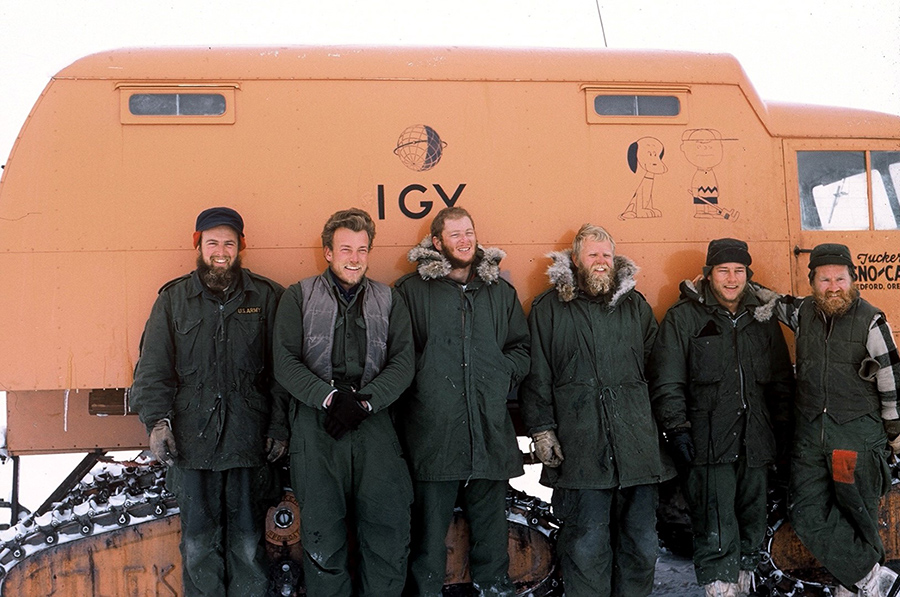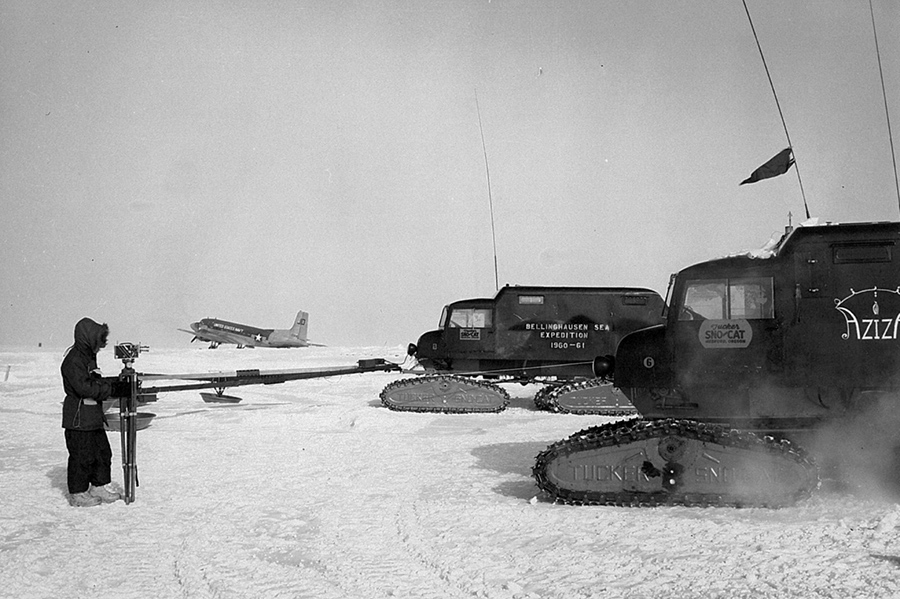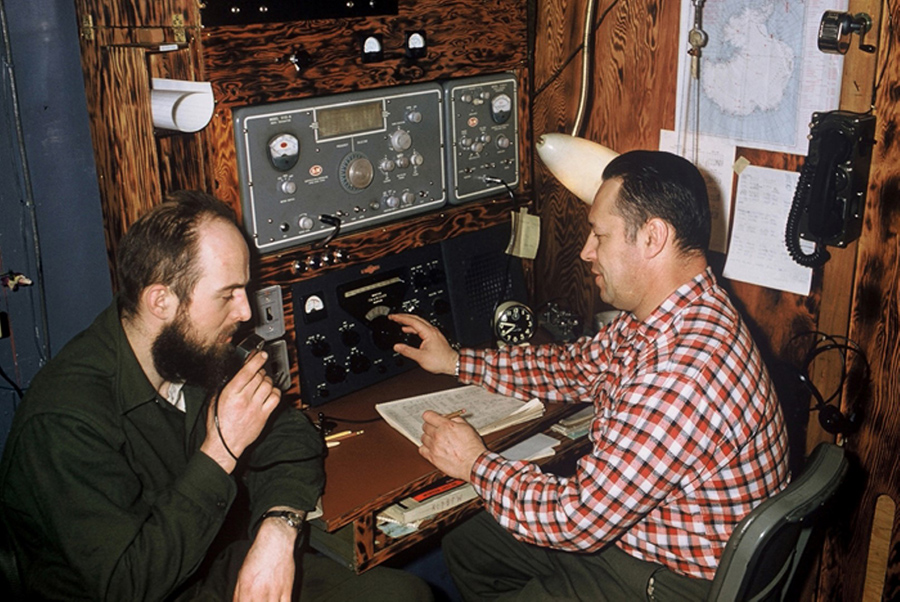
Photo Credit: David Holland
|
Charles Bentley stands in front of an LC-130 after arriving at the West Antarctic Ice Sheet drilling camp, known popularly as WAIS Divide,
in January 2008.
|
Charles Bentley 1929-2017
The Glaciologist Who First Measured the Full Depths of Antarctic Ice
By Michael Lucibella, Antarctic Sun Editor
Posted August 30, 2017
Charles Bentley, the pioneering glaciologist who was among the very first wave of scientists to travel to Antarctica, passed away on August 19 at his home in Oakland, Calif. at the age of 87.

Photo Credit: Charles Bentley
Charles Bentley, far left, and the rest of the Byrd Station traverse team pose in front of a Tucker Sno-Cat in February 1958 after a season of discoveries around West Antarctica. Bentley served as the expedition's seismologist during the 25 months he spent on the Ice during the International Geophysical Year.
Over his distinguished career, he made numerous discoveries that fundamentally changed the scientific community’s understanding of Antarctica.
Bentley was born on December 23, 1929 in Rochester, New York and earned his undergraduate degree in physics from Yale University. Though he originally planned on studying law after receiving his bachelor’s, he changed to geophysics after spending a summer at sea in the Atlantic on a Columbia University-led oceanographic expedition.
It was while he was enrolled at Columbia that his professor asked if anyone wanted to travel to the Antarctic as part of the International Geophysical Year, the multinational Earth sciences effort that was just starting to gear up and would mark the first permanent U.S. presence in Antarctica. He left the day after defending his PhD thesis at Columbia University, only to find out when he returned in 1959 that he hadn’t yet been officially awarded his degree because of an overlooked $50 dissertation fee.
Bentley first set foot on Antarctica in 1957, disembarking at the former Little America station on the Ross Ice Shelf. It would be 25 months of productive research before he left.
During this two-year long deployment he spent two winters at the now defunct Byrd Camp deep in the interior of West Antarctica. During the summers, he spent countless hours driving more than 3,000 miles across the then largely unexplored continent in a Sno-Cat tracked vehicle.
It was along these traverses that Bentley made his first great contribution to glaciological research.

Photo Credit: U.S. Navy
Tucker Sno-Cats line up before departing on the Bellingshausen Sea Traverse in 1960, a three-month scientific journey around the Bellingshausen Sea led by Charles Bentley.
As he and his team crossed West Antarctica, they laid geophones across the top of the ice sheet and then detonated explosives nearby. The instruments listened for the blast’s echo from the bedrock below to measure the depth of the ice, a technique he had helped develop in Greenland over the two years before traveling to Antarctica.
The results fundamentally changed the way scientists viewed the continent. He found that the ice wasn’t just a relatively thin layer on top of solid ground as scientists had presumed, but was up to three kilometers deep in some spots, and that it extended far below sea level.
In addition, he and his team were the first to see and chart much of the Ellsworth Mountains, a mountain range as high as the Rockies that stretches along the edge of the Weddell Sea. The highest peak in the range was named after him.
Using his geophones, he also discovered an enormous trench the size of Mexico underneath the ice in West Antarctica. The Bentley Subglacial Trench is the deepest point in Antarctica, and the largest subglacial trench in the world.
"I claim to be the only person with a hill and a hole named after him," Bentley told an interviewer at the University of Alaska, Fairbanks in 2008.
He joined the University of Wisconsin’s department of glaciology and geophysics (now the department of geosciences) in 1961, where he taught until 2000 when he left to lead the Ice Drilling Design and Operations, a program at the university that designs and operates ice drills.

Photo Credit: Charles Bentley
Charles Bentley, left, uses a ham radio while sitting next to station leader Steve Barnes at Byrd Station during his second winter of the International Geophysical Year.
He returned to Antarctica 15 more times over his career. In 1986, Nature featured his research on its cover when he and his colleagues showed that glaciers aren’t frozen to bedrock, but instead flow quickly over wet till.
His research mapping and understanding the structure and dynamics of ice forms the basis for much of the modern understanding of glaciers and how they’re affected by climate change.
On his most recent visit to the Antarctic, he was the project lead for the University of Wisconsin’s Ice Core Drilling Service in 2010 as it drilled deep into the West Antarctic Ice Sheet (WAIS), not far from the former Byrd Camp.
"I’m practically back home after 50 years," he told The Antarctic Sun at the time.
Bentley was a highly respected scientist in his field and served as the chairman of the Polar Research Board at the National Academies of Science from 1981 to 1985. He received the Bellingshausen-Lazarev Medal from the Soviet Academy of Sciences in 1971, and the Seligman Crystal from the International Glaciological Society in 1990, its highest honor. He published more than 200 papers and was an elected fellow at the American Association for the Advancement of Science, the American Geophysical Union and the Arctic Institute of North America.
"Charlie was a remarkable field scientist," said Sridhar Anandakrishnan, a glaciologist at Penn State University. "He brought modern techniques to Antarctic field exploration and was always pushing into new directions for measuring and understanding the ice sheet’s shape, structure, and behavior."
Anandakrishnan was a student of Bentley’s at the University of Wisconsin, Madison.
"He was a demanding and exacting mentor," Anandakrishnan said "I learned an enormous amount from him and his team at Wisconsin, and have tried to train my own students the same way."








